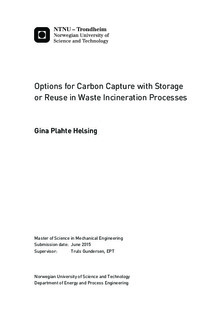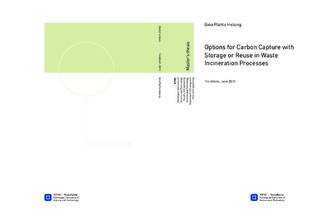| dc.description.abstract | Motivated by the ascertain need for climate mitigation, more than 100 countries have endorsed the goal of reducing their emissions. The maximum of a two degree rise is emphasised but despite this, fossil fuels are predicted to remain the main source of energy in Europe in the foreseeable future. By applying carbon capture technology, we can combat climate change whilst enabling the continued use of fossil fuels.
Carbon Capture and Storage (CCS) technology is predicted to be the most important low cost technology for CO2 capture. By applying capture technology on plants utilising biomass, negative CO2 emissions are achievable, which will thus deprive the atmosphere of CO2, and Klemetsrud waste incineration plant is one such plant. Though transport and storage of the recovered CO2 are equally important in CCS projects, capture technology has been the main area of focus in this work.
This report presents the available CCS technologies and makes a recommendation as to which CO2 capture technology is best suited for Klemetsrud. Klemetsrud represents a flue gas point source with a CO2 concentration of 11,5 vol% at atmospheric pressure. Due to these limiting factors, as well as being a retrofit project, post-‐combustion capture using amines was evaluated to be the best suited technology. Different amines and relating processes were evaluated based on the energy penalty they will impose on the incineration plant and the maturity of the technology. In general, amine based technologies are associated with large energy penalties, but through extensive and proper integration and choosing the right process, an acceptable efficiency is achievable.
Amines have been utilised in the process of removing CO2 for decades, and is therefore regarded as a mature technology. MEA is the most common amine, but less energy intensive processes using hindered amines are also commercialised. The world s first commercially scaled power plant is utilising the Cansolv process, which uses a proprietary hindered amine.
Basted on a literature study, energy saving capture processes and changes to the incineration and capture plant were suggested to achieve a higher efficiency. The most promising retrofit of the incineration plant is implementing oxygen enriched combustion. This technology is not mature and was therefore not recommended for EGE at this point, but in combination with post-‐combustion capture it is emphasised that this technology has great potential.
Transport on a large scale is usually carried out by ship or pipelines. There is no such network in Norway, and transport is therefore predicted to be carried out by rail or road tankers, and is therefor not disused in detail. Utilisation and permanent storage of the recovered CO2 is discussed based on the emission reduction effect. An attractive way of utilising CO2 while at the same time ensuring permanent storage in Norway is through Enhanced Oil Recovery (EOR). CO2 specifications have been listed for the main areas of CO2 application. | |

